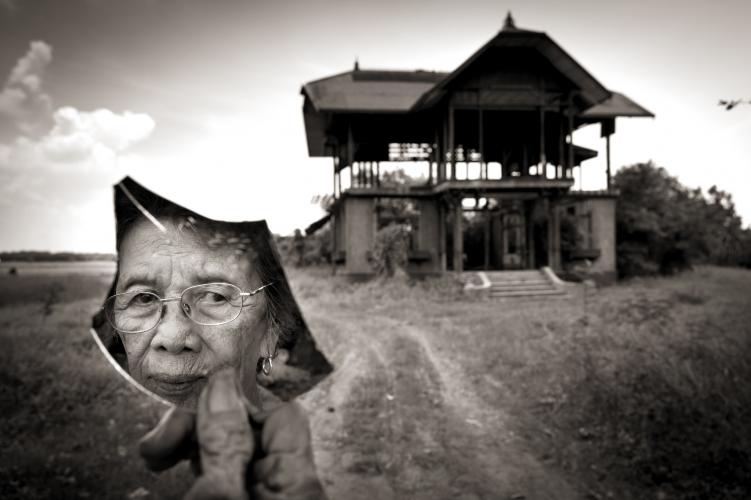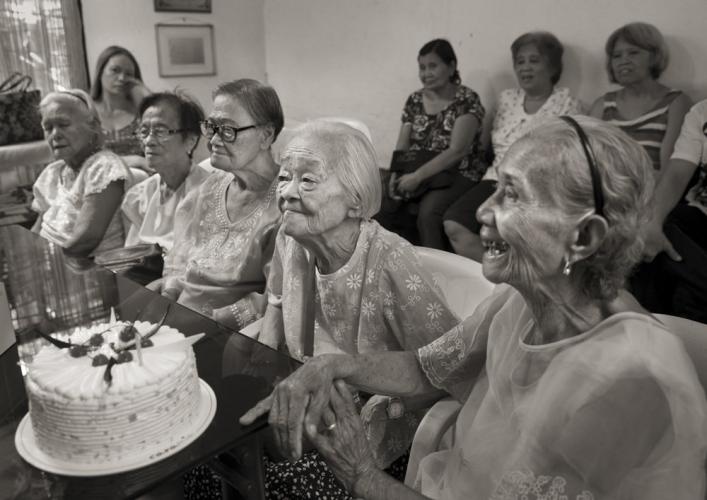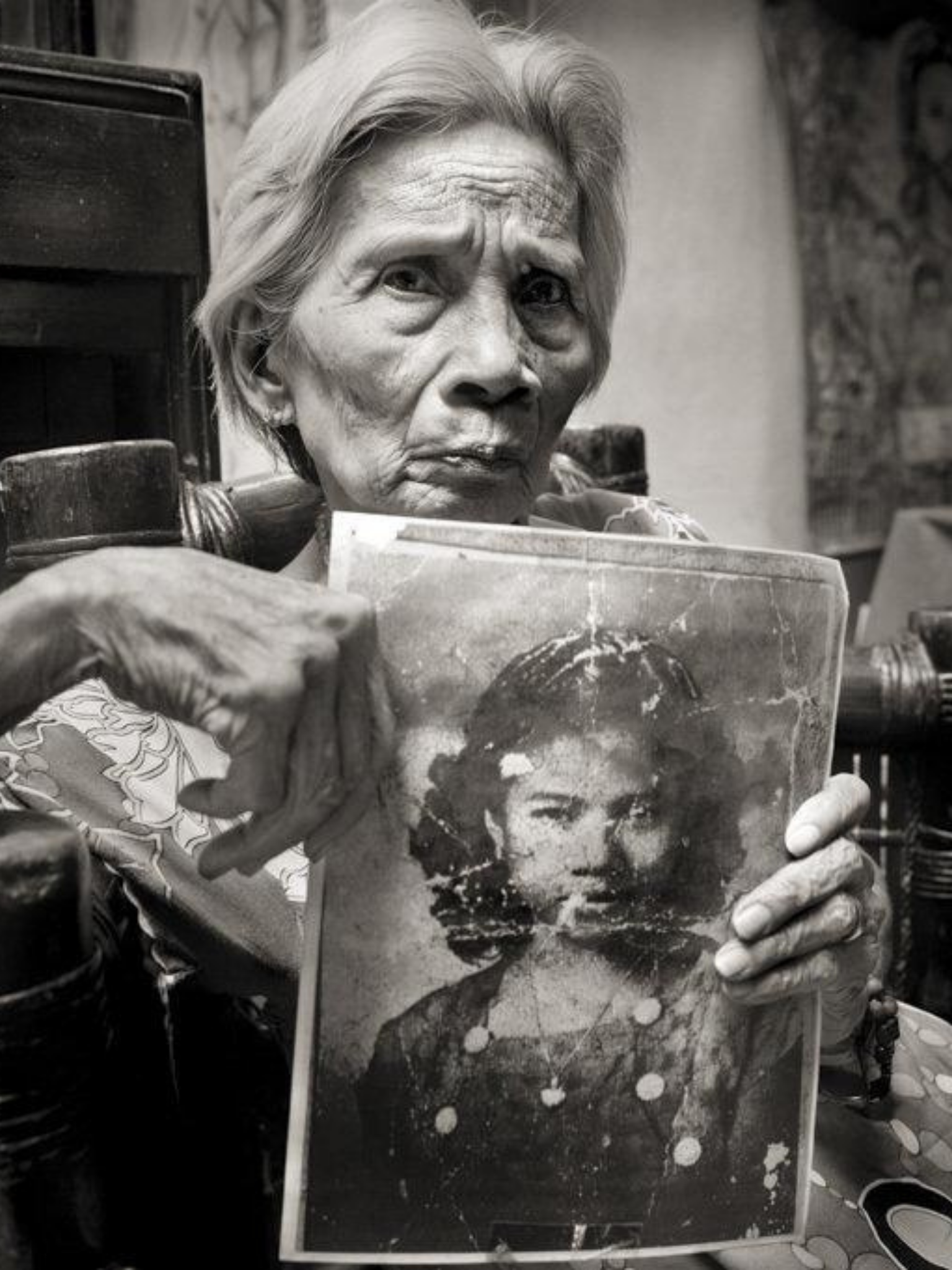
The project Lolas: Survivors of Enslavement began in 2019 as a collaboration between photojournalist Cheryl Diaz Meyer and reporter Julie McCarthy of National Public Radio. For almost two years Diaz Meyer and McCarthy worked to interview and photograph the survivors of sexual servitude under Japanese imperial rule during World War II. The women have historically been called “comfort women,” a categorically complex term coined from a Japanese word, a term some survivors have sought to reclaim.
Many countries colonized under the Japanese in World War II have legacies of sexual servitude seeped into their history. Understanding the violence and trauma these women endured in testimonial accounts over the last decades has been critical. Japan and other governments have been forced to reckon with this often hushed and shared history in recent decades. How the Japanese government considers reparations and healing remains contentious publicly and politically, despite more recent acknowledgments of this history.
"This was always going to be a difficult story to tell. The abuse that invading Japanese soldiers inflicted upon tens of thousands of women in occupied countries during World War II has been well-documented, but what became of these women forced to serve as sex slaves? And how to tell their story? Cheryl's powerful black-and-white images found a way that captures the dignity of these women—and the lasting hurt of the brutality they suffered," said Tom Hundley, senior editor at the Pulitzer Center.
Pulitzer Center Outreach Intern Katherine Jossi spoke with Diaz Meyer about Lolas: Survivors of Enslavement, Diaz Meyer’s reflections on the importance of telling these women’s stories, and her own history intersections with the project. This interview has been edited for length and clarity.
Katherine Jossi: Can you tell me about your history with photojournalism and what first got you interested?
Cheryl Diaz Meyer: When I was in college, I was at the University of Minnesota Duluth. I had a friend who introduced me to photography, she was an art major, and I went on a photoshoot with her. She introduced me to the darkroom, and it was mind-blowing. I had never seen the process of creativity in that light, where it was a terrifying and exhilarating experience of discovery, where I didn't know what I was going to find. That was never anything I'd had the luxury or the dare to challenge myself to do. So the experience of going out and taking pictures, and simply seeing, just blew me away. I continued, I experimented, I started taking classes. I was taking art photography classes, which are very different from photojournalism. Art photography is about aesthetics. It's about how photography emanates from you. It's an exploration really, of your eye and yourself. So that was, in truth, a wonderful way to start.
As I was exploring and learning photography, I started going to the library and one day, I found this photo book. I wish I could recall what it was. But I remember feeling this immense high. I was crying because I was so moved by the work and I knew in my heart, I need to do something like this—something that moves me to the point of such pure joy. I wanted that for my life. But I didn't know how to get it.
By chance, I had a political science professor named Craig Grau, who stopped me in the hallway one day, which led to a conversation about what I wanted to do with my life. To this day, I don’t know why he took an interest in asking me this question because I was one of the thousands of students that he had taught.
I couldn't verbalize it. I was too terrified. What if I didn’t ever achieve my dreams? Gently, he said, “If money wasn't an issue, what would you do?” And it all came spilling out. I told him I wanted to be a photographer, I wanted to tell stories about people. Two weeks later, he handed me a piece of paper with the names of the three top universities in the country for photojournalism. His gesture gave me the courage to take the steps to attain my goals. I would eventually complete a second bachelor’s in photojournalism at Western Kentucky University and that education helped me start my career.
KJ: Tell me about how this project came to be. What was the significance of telling this story?
CDM: I grew up in the Philippines, the history of World War II was incredibly alive. My mother talked about it, my aunts, and uncles talked about it. They would say, “In the time of the Japanese, we had to hide in caves during the bombing. In the time of the Japanese, your grandfather helped guerillas by ferrying arms to them in a vegetable basket. In the time of the Japanese ...” It was always like that. I grew up with the stories of the war, even though it happened 30 years before that time. There were a lot of those comfort stations in my region of the Philippines, and never was this spoken about. My mother knew nothing about it.
In recent years, I spoke about this project with friends I grew up with in the Philippines. They told me they knew about “comfort women” because they would hear their mothers speaking about the women, denigrating them. They would say, “Oh, she was a Japayuki, a prostitute for the Japanese.” There was a presumption that they had served willingly. In truth, they were deceived with promises of jobs for laundry and cooking. Once they got into the garrisons, they did that in the daytime, and in the evening, they served in a different way. When I came across this history, I wanted to learn more, because I wanted to better understand it.
My early research was fraught with contradictions, it seemed there were only a handful of these women left. I wanted to hear their stories because that history has been tamped down. Nobody wants to talk about it. These women have been shamed into silence for years.
I wanted to understand how that affects them? Their families? If I lived the history of what my grandfather did, in a way that felt incredibly real, I wanted to know, how did that history stay alive for these women? How did they develop relationships, families? How were those families affected? How did this horror come to be? I've covered quite a bit of conflict in my career. The violence against women and girls in the context of conflict continues today. It is earth-shattering. It's ruinous, not just for the women, but for the entire communities that these women live in. The fabric of these communities is destroyed by the violence that is perpetrated against them. I wanted to show the legacy of the violence.
KJ: What was the most surprising thing you learned during this project?
CDM: When I met the women, this dichotomy of reconciling their past and their current lives, finding joy in what they do today. Even though the survivors are in their late 80s, early 90s, many of them were children — not even young women — some as young as 8 years old were raped. This dichotomy of them in their current lives, being able to pick up the shattered pieces of their inner selves, finding joy, being able to nurture their children, some of whom turned on them when they came out publicly with their stories.
KJ: I was wondering if you could tell me a little about the process and tools you used in creating these photographs?
CDM: I shot with digital DSLR cameras. Some of the images were documentary and in the moment. The portrait of the woman with the mirror was planned. I wanted to have an image that reflected the history, and the women today. I thought a mirror would be a poetic way to combine the past and the present.
KJ: How do you think photojournalism can be used to better understand history?
CDM: There are ways that the past reflects today. As photojournalists, sometimes we work in anthropological ways. When doing that, one has to be thoughtful. It takes a lot of research. I spent many months researching the story before I actually made the trip. I knew most of what I would be shooting. I was always open to what I would be surprised with. I had very few contacts. I had a couple of small entrees that I knew were going to get me access to a couple of different things. I also knew that it was going to take being on the ground and meeting and talking to people for the reporting to progress. Even with the survivors, the difference between the first visit and the second visit is the difference between the doors opening and the world becoming clear. That kind of depth only comes from commitment. It takes trust and courage to take the leap of faith.
KJ: What is the difference and maybe even some similarities between photographing conflict and doing more long-form photojournalism projects like this?
CDM: Conflict is very much in the moment, you don't know what is going to happen. So you go into it as prepared as you can be with backup plans, and then be completely flexible to what you experience. With long-form, there is so much more research that goes into it. You have more time on your hands, so you can be even better prepared. The moments may be quieter.
Conflict is in your face. It takes a lot of quick thinking on your feet. I think having a strong moral compass is critical because there are so many ethical dilemmas. It can happen very fast and furiously. You may have to make the right decisions multiple times a day. Do you risk your life? Are you risking someone else's life?
KJ: Did you encounter any challenges in creating this story?
CDM: The biggest challenge was finding the women because the women are old, they're dying, they have a lot at stake, they want justice. Yet, the main organization in Manila was very intent on protecting them from the media. They wanted to control the narrative that the women shared, they wanted it to be very specific and limited. The interviews had to happen in their office on their time. That was difficult.
I had to find a way to reach out to these women to connect with them and find women beyond that because not all the women were associated with this one group. There are many women that live in other parts of the country and it took research to find them. I believe there are more out there. We were able to identify about 45 women of 1,000. We spoke with about 25. Some were incapacitated and couldn't talk. Others suffered from dementia. That we were able to identify that many were shocking to me.

KJ: I am curious as to how this project might inform future work? And what’s next for you?
CDM: I'm hoping to pursue this project further, possibly in China. There were “comfort women” all over Asia in almost all the Japanese-occupied territories. I have a contact who will help me with the Chinese part and I'm still doing the legwork in Indonesia. Time is of the essence. With the pandemic, it is very challenging, because I can't travel safely.







